
Warning: this post contains graphic details and may be distressing for some readers.
On January 15, 1947, Betty Bersinger and her three-year-old daughter were walking past a vacant lot near their home in Los Angeles when Bersinger spotted what looked like a broken mannequin lying in the weeds.
In fact, it was the body of a young, dark-haired woman. She had been cut in half at the waist, and the upper and lower halves placed a foot apart. She had been mutilated – her face slashed from the corners of her mouth up to her ears, her uterus removed. She had been drained of blood, leaving her skin white.
The cutting and draining was done with such precision that one of the investigators, Detective Harry Hansen, declared that her killer was most likely a “top medical man”.
At first, the horrific crime was dubbed “the werewolf murder”. But before long, the victim became known as “the Black Dahlia” – a nickname she’d had before she died. Seventy years later, the case remains open. But now a new book claims to have compelling evidence that proves who the killer was.
It didn’t take police long to identify the young woman as Elizabeth “Betty” Short. Her fingerprints were on record because she had been arrested four years earlier, at the age of 18, for underage drinking.
Short’s childhood was messed up. Her father, Cleo, lost most of his money when the Great Depression hit, and faked his suicide, leaving his car near a bridge. Short was aged just five at the time. Her mother Phoebe took on several jobs to look after Short and her four sisters.
